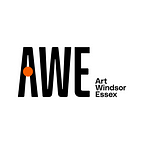Artist Spotlight: Naomi Peters
Meet artist Naomi Peters, who is a Potawatomi/Chippewa (Ojibwe) member of the Caldwell First Nation. She recently graduated from Tyndale University of Toronto with a Bachelor of Arts (English Major/Psychology Minor), and has been drawing for over a decade. Naomi was one of three artists chosen to create a mural on the Gordie Howe International Bridge tower construction site, along with artists Teresa Altiman and Daisy White. The artists’ murals will be visible from both sides of the border for the next two years.
Currently, Naomi Peters’ work is on view at the AGW as part of The Bridge Artists; an exhibition on the second floor of the Gallery that will be ongoing until January 9th, 2022. Further, for people interested in meeting Naomi, now they can! On Saturday, October 23rd, from 11am-12:30pm, participants can join Naomi Peters in the second floor studio to learn about Indigenous art-making techniques, symbols, and animals. There are only a few spaces remaining, so we encourage interested participants to click here and register for this engaging workshop!
Want to learn more about Naomi Peters? Read on for an interview with Naomi and our Head of Programs and Collection, Julie Rae Tucker:
JT: Please introduce yourself: name, where you live and work, and where you went to school.
NP: Okay, so Boozhoo, Naomi nidishinikas, I’m Naomi Peters, I’m a member of Caldwell First Nation. I’m situated just outside Toronto and Richmond Hill. I am currently doing a bit of freelance in this odd time, and I graduated with a BA from Tyndale University.
JT: How did you start making art?
NP: I kind of just started making art, just with everyone else anytime there was an assignment in class, but I took a special interest in art around age 12, when the teacher started pointing out that he liked the composition of my works. And I’d always had an interest in it because of my dad and grandfather who both like to draw, and that somehow just became me practicing every day.
JT: What do you think about when you’re making work?
NP: When I’m making specifically my Indigenous series, I like to think about the specific animal I’m drawing, the way it moves, the different components of its body, how to make that shape seem alive to the people viewing it. And I’m usually thinking about what types of colors would make that animal stand out the most.
JT: Tell me a little bit about the work on the bridge mural.
NP: So, the bridge, art, I was called down to Walpole, we had a couple initial meetings about what kind of common themes and colours kind of symbols we wanted to incorporate. And then that became me drawing the hoop dancer, where visually you can see the four directions and his hoops, as well as the four medicines. Those were specific symbols I wanted to represent by the hoops because I thought it would be nice to display an image where it had hope and healing as the message, as well as the colours.
JT: Could you talk about the Indigenous animal series that is on view at the Gallery?
NP: Yeah, so I started that about 2018 I believe, I’d have to look back at the exact date, it might have actually been 2017, and it started because I wanted to draw an otter for my mother because she’s always been a very loving mother to me. And I wanted to give her something that was representative of our relationship as a child of mixed origin from her and my Native Father and to respect her. And so I started by drawing an otter who was holding a stone, but where the image of the otter is also pregnant to represent the relationship between her and my brother and then also me because in our culture swallowing a stone represents becoming pregnant. So, it kind of just went from there.
JT: That’s great. Is there a particular person or thing that inspires you?
NP: I don’t know if it’s a particular person or thing. I feel I become more inspired just the more I look at beautiful things, I desire to make something beautiful myself. I think I just draw inspiration from my surroundings, if that makes sense.
JT: It makes total sense. I think that’s a really important thing an artist does.
JT: Do you have any advice for emerging artists?
NP: I would say do what I didn’t at first and just practice a lot more because there’s a lot of times when artists are prone to fall into slumps or where you won’t feel like drawing, even though you want to draw. So, to push through that, even if you have to just copy an image you like or just practice linework or shading whatever it is, it’s better to put in the time, even on your downtime, because it will really help you hone your skills.
JT: What do you think is the role of the artist?
NP: Well, I think with all art, whether it’s music like painting, drawing, whatever it is, is to evoke emotion, and people in the audience. And I think if something doesn’t make someone else feel anything by looking at it or hearing it, whatever it is, then it’s ultimately a failure.
JT: Okay, I hear that, anything else that you’d like to mention about your work that I didn’t ask?
NP: Just with my work, I hope that anyone who sees it finds it enjoyable and it brings out a feeling of enjoyment and happiness while viewing.
JT: Yes, joy, that’s a great place to work from. Chi miigwetch, thank you very much for meeting with me.
